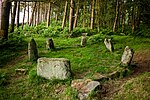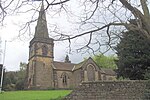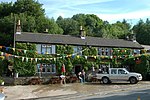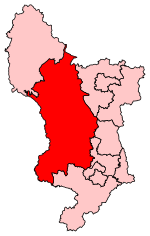Andle Stone
Archaeological sites in DerbyshireBuildings and structures in DerbyshireDerbyshire geography stubsMegalithic monuments in EnglandStone Age sites in England ... and 1 more
Tourist attractions in Derbyshire

The Andle Stone is a large gritstone boulder on Stanton Moor in Derbyshire. The stone block is 6m long, 4m high and lies within a low, circular, dry stone wall enclosure. It is covered in cup and ring marks. It is also known as the Oundle Stone, the Anvil Stone or the Twopenny Loaf.There is a memorial inscription on the west-facing concave face of the boulder, commemorating the Duke of Wellington, Lieutenant Colonel William Thornhill (2nd son of Bache Thornhill of Stanton Hall) and the battles of Assaye and Waterloo. The inscription reads: The Andle Stone and the nearby Doll Tor stone circle are both on private farmland with no public access rights.
Excerpt from the Wikipedia article Andle Stone (License: CC BY-SA 3.0, Authors, Images).Andle Stone
Birchover Road, Derbyshire Dales Stanton CP
Geographical coordinates (GPS) Address External links Nearby Places Show on map
Geographical coordinates (GPS)
| Latitude | Longitude |
|---|---|
| N 53.16355 ° | E -1.642045 ° |
Address
Andle Stone (Oundle Stone;Anvil Stone;Towopenny Loaf)
Birchover Road
DE4 2LS Derbyshire Dales, Stanton CP
England, United Kingdom
Open on Google Maps











